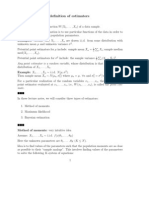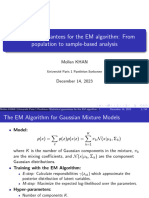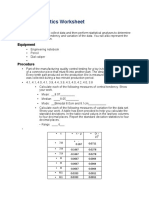Lecture 13. em Algorithm (After-Class)
Uploaded by
laijiahao0430Lecture 13. em Algorithm (After-Class)
Uploaded by
laijiahao0430Lecture 13.
EM Algorithm (After-class)
Notes: As we saw before, many estimation problems require maximization of the probability
distribution with respect to an unknown parameter, for example when computing ML estimates of the
parameters or MAP estimates of the hidden random variables. For many interesting problems,
differentiating the probability distribution with respect to the parameter of interest and setting the
derivative to zero results in a nonlinear equation that does not have a closed-form solution. In such
cases, we have to resort to numerical optimization.
Maximum likelihood estimation with unknown parameters
1 w.p.
Example: Let w be Bernoulli r.v., w = {
δ
, y (binary r.v.) be a noise
0 w.p. 1 − δ
observation of w .
y=
PY ∣W (y∣w) = { w
ϵ
1−ϵ y=w
Let w = [w1 , ⋯ , wn ]T be n i.i.d. samples of w .
y = [y1 , ⋯ , yn ]T
We do not observe w , but observe y .
Our goal is to estimate δ and ϵ.
n
ML: PY (y; ϵ, δ) = ∏i=1 PYi (yi ; ϵ, δ)
n
= ∏ [PYi ∣Wi (yi ∣wi = 0; ϵ, δ)PWi (0; ϵ, δ) + PYi ∣Wi (yi ∣wi = 1; ϵ, δ)PWi (1; ϵ, δ)]
i=1
latent r.v.
(ϵ∗ , δ∗ ) = arg max PY (y; ϵ, δ)
ϵ,δ
No close form solution for the optimal ϵ, δ.
Lecture 13. EM Algorithm (After-class) 1
Algorithm to compute the optimal parameters with hidden variables ⇒ EM Algorithm.
General setup
Assume complete data z , generate by PZ (⋅; x), and x is the parameter to estimate.
Can only observe y = g(z), observe data, g: deterministic function.
In our example: z = [w , y], y = y, x = [ϵ, δ]
The goal is to find x∗ = arg max PY (y; x) = arg max log PY (y; x)
x x
PZ Y (z,y;x)
Note that PZ (z; x) = ∑y PZ ∣Y (z∣y; x) ⋅ PY (y; x) = PZ ∣Y (z∣g(z); x) ⋅ PY (g(z); x)
⇒ let y = g(z): log PY (y; x) = log PZ (z; x) − log PZ ∣Y (z∣y; x)
Do expectation of both sides over PZ ∣Y (z∣y; x′ ):
LHS= ∑z ′ PZ ∣Y (z ′ ∣y; x′ ) log PY (y; x) = (∑z ′ PZ ∣Y (z ′ ∣y; x′ )) log PY (y; x) =
log PY (y; x)
RHS= E[log PZ (z; x)∣Y = y, x = x′ ] −E[log PZ ∣Y (z∣y; x)∣Y = y, x = x′ ]
U (x,x′ )≜ ∑ z ′ PZ ∣Y (z ′ ∣y;x′ ) log PZ (z ′ ;x) V (x,x′ )≜− ∑ z ′ PZ ∣Y (z ′ ∣y;x′ ) log PZ ∣Y (z ′ ∣y;x)
⇒ log PY (y; x) = U(x, x′ ) + V (x, x′ ), ∀x′ .
Lemma: V (x, x′ ) ≥ V (x′ , x′ )
PZ ∣Y (z∣y;x′ )
Proof: V (x, x′ ) − V (x′ , x′ ) = ∑z PZ ∣Y (z∣y; x′ ) log PZ ∣Y (z∣y;x)
=
D(PZ ∣Y ;x′ ∥PZ ∣Y ;x ) ≥ 0
′ ′ ′ ′
⇒ If we can find x =
x such that U(x, x ) ≥ U(x , x ), then
log PY (y; x) = U(x, x′ ) + V (x, x′ ) ≥ U(x′ , x′ ) + V (x′ , x′ ) = log PY (y; x′ )
Lecture 13. EM Algorithm (After-class) 2
EM Algorithm:
^(0)
1. Initialization: choose a x
2. Repeat until convergence:
^(n) , compute
E-step: given the previous estimation x
^(n) ) = E[log PZ (z; x)∣Y = y, x = x
U(x, x ^(n) ]
^(n+1) maximizing U(⋅; x
M-step: find x ^(n) )
^(n+1) = arg max U(x; x
x ^(n) )
x
^(n+1) , x
⇒ U(x ^(n) ) ≥ U(x
^(n) , x
^(n) )
^(0) , x
We can get a sequence of x ^(1) , ⋯ such that
^(0) ) ≤ PY (y; x
PY (y; x ^(1) ) ≤ ⋯
Since PY (y; x) ≤ 1, it is a non-decreasing bound sequence ⇒ it must converge.
EM Algorithm converges to a stationary point of the likelihood function, i.e., let x∗ be the
∂
convergent point, then ∂x PY (y; x)∣x=x∗ = 0
EM Algorithm for mixture model
Mixture model:
Assume data generated by the following process:
1. sample li ∈ {1, ⋯ , k}, i = 1, ⋯ , m and li ∼ multinomial(ϕ), ϕ = [ϕ1 , ⋯ , ϕk ] (
∑ki=1 ϕi = 1)
2. Sample observation yi from some distribution P (li , yi )
P (li , yi ) = P (li ) ⋅ P (yi ∣li )
Mixture Gaussian model: P (yi ∣li = j) ∼ N (μj , Σj )
Lecture 13. EM Algorithm (After-class) 3
In our notation,
⎧ϕ = [ϕ1 , ⋯ , ϕk ]
x = [ϕ, μ, Σ] : ⎨μ = [μ1 , ⋯ , μk ]
⎩Σ = [Σ , ⋯ , Σ ]
1 k
z = [l1 , ⋯ , lm , y1 , ⋯ , ym ]
y = [y1 , ⋯ , ym ]
The EM Algorithm:
E-step:
^(n) ) = EPZ ∣Y (⋅∣y;x^(n) ) [log PZ (z; x)∣Y = y, x
U(x, x ^(n) ]
m k
= ∑ ∑ P (li ∣yi ; x
^(n) ) log P (li , yi ; x)
i=1 li =1
M-step:
^(n+1) = arg max U(x; x
x ^(n) )
x
The Mixture Gaussian:
E-step:
( ) ( )
Lecture 13. EM Algorithm (After-class) 4
P (yi ∣li = j; x
(n) ^(n) ) ⋅ P (li = j; x ^(n) )
P (li = j∣yi ; x
^ )=
^(n) )
P (yi ; x
P (yi ∣li = j; x ^(n) ) ⋅ P (li = j; x^(n) )
= k
∑j ′ =1 P (yi ∣li = j ′ ; x
^(n) ) ⋅ P (li = j ′ ; x
^(n) )
(n)
^ ∣− 2 exp(− 1 (yi − μ
∣2π Σ
(n) d
^
^j )T Σ
(n) (n)−1
^j )) ⋅ ϕ^j
(yi − μ
(n)
j 2 j
=
^ (n)
∑kj ′ =1 ∣2π Σ ′ ∣− d2 exp(− 1 (y − μ
i ^
(n) T ^ (n)−1
′ ) Σ ′ (yi − ^
μ
(n)
′ )) ⋅ ϕ^j ′ (n)
j 2 j j j
≜ wij
^(n) ) ∀x
⇒ Compute U(x, x
m k
^ ) = ∑ ∑ wij log P (li = j, yi ; x)
U(x, x (n)
i=1 j=1
m k
= ∑ ∑ wij (log P (li = j; x) + log P (yi ∣li = j; x))
i=1 j=1
m k
1 1
= ∑ ∑ wij (log ϕj − log(2π)d ∣Σj ∣ − (yi − μj )T Σ−1
j (yi − μj ))
i=1 j=1
2 2
find x∗ ^(n) )
= arg max U(x, x
x
M-step: updating parameters
k
Do the derivatives on ϕj . Note that ∑j=1 ϕj = 1. Use the Lagrangian multiplier method.
^(n) ) − λ(∑j=1 ϕj − 1) ∣
k
∂U(x, x m
∑i=1 wij
= −λ=0
∂ϕj ^
ϕ
(n+1)
∣ϕj =ϕ^j
(n+1)
j
k
By ∑j=1 ϕj = 1, λ = ∑m k
i=1 ∑j=1 wij = m, and then
m
1
ϕ^j ∑ wij
(n+1)
=
m
i=1
Do the derivatives on μj
Lecture 13. EM Algorithm (After-class) 5
m
^(n) ) ∣
∂U(x, x
= − ∑ wij Σ−1
(n+1)
j (yi − μ
^j )=0
∂μj ∣μj =μ^(n+1)
j i=1
Then, we have
m
(n+1) ∑ wij ⋅ yi
^j
μ = i=1m
∑i=1 wij
Do the derivatives on Σj
^(n) ) ∣
∂U(x, x
∂Σj ∣Σj =Σ^(n+1) ,μj =μ^(n+1)
j j
m
1 ^ (n+1)−1 ^ (n+1)−1
= − ∑ wij (Σ
(n) (n) T ^ (n+1)−1
j − Σ j (yi − ^
μ j )(yi − ^
μ j ) Σj )=0
i=1
2
m
⇒ ∑ wij (Σ
^ (n+1) − (yi − μ(n) (n)
j ^j )T ) = 0
^j )(yi − μ
i=1
Then, we have
(n) (n)
∑m
i=1 wij (yi − μ
^j )(yi − μ
^j )T
^ (n+1)
Σ =
j
∑mi=1 wij
Lecture 13. EM Algorithm (After-class) 6
You might also like
- Mixture Models and Expectation-Maximization: Justus H. PiaterNo ratings yetMixture Models and Expectation-Maximization: Justus H. Piater11 pages
- The EM Algorithm: Ajit Singh November 20, 2005No ratings yetThe EM Algorithm: Ajit Singh November 20, 20054 pages
- Statistical Inference III: Mohammad Samsul AlamNo ratings yetStatistical Inference III: Mohammad Samsul Alam32 pages
- EM-algorithm: California Institute of Technology 136-93 Pasadena, CA 91125 Welling@vision - Caltech.eduNo ratings yetEM-algorithm: California Institute of Technology 136-93 Pasadena, CA 91125 Welling@vision - Caltech.edu7 pages
- 8th Lecture Note - 1039837803 230515 094639No ratings yet8th Lecture Note - 1039837803 230515 09463910 pages
- 11 Hidden Markov Models (HMMS) Model and Problem DescriptionNo ratings yet11 Hidden Markov Models (HMMS) Model and Problem Description15 pages
- A Derivation of The EM Updates For Finding The Maximum Likelihood Parameter Estimates of The Student's T DistributionNo ratings yetA Derivation of The EM Updates For Finding The Maximum Likelihood Parameter Estimates of The Student's T Distribution5 pages
- Point Estimation: Definition of EstimatorsNo ratings yetPoint Estimation: Definition of Estimators8 pages
- An Introduction To Variational Calculus in Machine LearningNo ratings yetAn Introduction To Variational Calculus in Machine Learning7 pages
- The Problem: Library (MASS) Data (Faithful) Attach (Faithful)No ratings yetThe Problem: Library (MASS) Data (Faithful) Attach (Faithful)7 pages
- Expectation Maximization (EM) Algorithm.pptxNo ratings yetExpectation Maximization (EM) Algorithm.pptx47 pages
- Tutorial On Generalized Expectation Maximization: Javier R. MovellanNo ratings yetTutorial On Generalized Expectation Maximization: Javier R. Movellan6 pages
- Isye 6416: Computational Statistics Spring 2023: Prof. Yao XieNo ratings yetIsye 6416: Computational Statistics Spring 2023: Prof. Yao Xie24 pages
- A Modified Expectation Maximization Algorithm For Penalized Likelihood Estimation in Emission TomorzradhvNo ratings yetA Modified Expectation Maximization Algorithm For Penalized Likelihood Estimation in Emission Tomorzradhv6 pages
- Expectation Maximization: Dekang Lin Department of Computing Science University of AlbertaNo ratings yetExpectation Maximization: Dekang Lin Department of Computing Science University of Alberta22 pages
- Variational Problems in Machine Learning and Their Solution With Finite ElementsNo ratings yetVariational Problems in Machine Learning and Their Solution With Finite Elements11 pages
- The Kullback-Liebler Distance and EntropyNo ratings yetThe Kullback-Liebler Distance and Entropy5 pages
- Stochastic Calculus Midterm Exam SolutionsNo ratings yetStochastic Calculus Midterm Exam Solutions6 pages
- Chapter 9.4 Allele Frequency EstimationNo ratings yetChapter 9.4 Allele Frequency Estimation24 pages
- Provably Powerful Graph Networks: Haggai Maron Heli Ben-Hamu Hadar Serviansky Yaron LipmanNo ratings yetProvably Powerful Graph Networks: Haggai Maron Heli Ben-Hamu Hadar Serviansky Yaron Lipman15 pages
- Functional Protein Design With Local Domain AlignmentNo ratings yetFunctional Protein Design With Local Domain Alignment20 pages
- Aligning Transformers With Weisfeiler-Leman: K K K KNo ratings yetAligning Transformers With Weisfeiler-Leman: K K K K51 pages
- R E P GNN G B: Ethinking The Xpressive Ower of S Via Raph IconnectivityNo ratings yetR E P GNN G B: Ethinking The Xpressive Ower of S Via Raph Iconnectivity60 pages
- On The Connection Between MPNN and Graph TransformerNo ratings yetOn The Connection Between MPNN and Graph Transformer23 pages
- He Who Has Never Learned To Obey Cannot Be A GoodNo ratings yetHe Who Has Never Learned To Obey Cannot Be A Good4 pages
- Performance-Related and Skill-Based Pay: An Introduction: ACT/EMP/17No ratings yetPerformance-Related and Skill-Based Pay: An Introduction: ACT/EMP/1744 pages
- Ta25du2.4 Ta25du3.1 Ta25du32 Ta25du11 Ta25du14 Ta25du4.0 Ta25du1.8 Ta25du25No ratings yetTa25du2.4 Ta25du3.1 Ta25du32 Ta25du11 Ta25du14 Ta25du4.0 Ta25du1.8 Ta25du258 pages
- (Ebooks PDF) Download (Ebook PDF) Understanding Patent Law, Third Edition 3rd Edition Full Chapters100% (3)(Ebooks PDF) Download (Ebook PDF) Understanding Patent Law, Third Edition 3rd Edition Full Chapters51 pages
- Announcing SAP API Business Hub Next Gen Experience General AvailabilityNo ratings yetAnnouncing SAP API Business Hub Next Gen Experience General Availability8 pages
- Ion Exchange Demineralizers: Big Problems, Small SolutionsNo ratings yetIon Exchange Demineralizers: Big Problems, Small Solutions10 pages
- Make A Copy and Edit in Google Slides. Download An Offline Copy and Edit in Microsoft PowerpointNo ratings yetMake A Copy and Edit in Google Slides. Download An Offline Copy and Edit in Microsoft Powerpoint43 pages
- ELYM 115 2nd Opp Examination MC-2022-09-21 TTNo ratings yetELYM 115 2nd Opp Examination MC-2022-09-21 TT3 pages
- Financial Management Theory and Practice 14th Edition Brigham Test Bank download pdf100% (15)Financial Management Theory and Practice 14th Edition Brigham Test Bank download pdf66 pages
- How To Get An Appointment With Anyone in 3 Simple StepsNo ratings yetHow To Get An Appointment With Anyone in 3 Simple Steps9 pages
- Recovery of Scattered and Precious Metals From Copper Anode Slime by Hydrometallurgy - A ReviewNo ratings yetRecovery of Scattered and Precious Metals From Copper Anode Slime by Hydrometallurgy - A Review17 pages
- Name: Roll No: Sub:: AIM Geometric ModellingNo ratings yetName: Roll No: Sub:: AIM Geometric Modelling9 pages
- Mixture Models and Expectation-Maximization: Justus H. PiaterMixture Models and Expectation-Maximization: Justus H. Piater
- EM-algorithm: California Institute of Technology 136-93 Pasadena, CA 91125 Welling@vision - Caltech.eduEM-algorithm: California Institute of Technology 136-93 Pasadena, CA 91125 Welling@vision - Caltech.edu
- 11 Hidden Markov Models (HMMS) Model and Problem Description11 Hidden Markov Models (HMMS) Model and Problem Description
- A Derivation of The EM Updates For Finding The Maximum Likelihood Parameter Estimates of The Student's T DistributionA Derivation of The EM Updates For Finding The Maximum Likelihood Parameter Estimates of The Student's T Distribution
- An Introduction To Variational Calculus in Machine LearningAn Introduction To Variational Calculus in Machine Learning
- The Problem: Library (MASS) Data (Faithful) Attach (Faithful)The Problem: Library (MASS) Data (Faithful) Attach (Faithful)
- Tutorial On Generalized Expectation Maximization: Javier R. MovellanTutorial On Generalized Expectation Maximization: Javier R. Movellan
- Isye 6416: Computational Statistics Spring 2023: Prof. Yao XieIsye 6416: Computational Statistics Spring 2023: Prof. Yao Xie
- A Modified Expectation Maximization Algorithm For Penalized Likelihood Estimation in Emission TomorzradhvA Modified Expectation Maximization Algorithm For Penalized Likelihood Estimation in Emission Tomorzradhv
- Expectation Maximization: Dekang Lin Department of Computing Science University of AlbertaExpectation Maximization: Dekang Lin Department of Computing Science University of Alberta
- Variational Problems in Machine Learning and Their Solution With Finite ElementsVariational Problems in Machine Learning and Their Solution With Finite Elements
- Provably Powerful Graph Networks: Haggai Maron Heli Ben-Hamu Hadar Serviansky Yaron LipmanProvably Powerful Graph Networks: Haggai Maron Heli Ben-Hamu Hadar Serviansky Yaron Lipman
- Functional Protein Design With Local Domain AlignmentFunctional Protein Design With Local Domain Alignment
- Aligning Transformers With Weisfeiler-Leman: K K K KAligning Transformers With Weisfeiler-Leman: K K K K
- R E P GNN G B: Ethinking The Xpressive Ower of S Via Raph IconnectivityR E P GNN G B: Ethinking The Xpressive Ower of S Via Raph Iconnectivity
- On The Connection Between MPNN and Graph TransformerOn The Connection Between MPNN and Graph Transformer
- Performance-Related and Skill-Based Pay: An Introduction: ACT/EMP/17Performance-Related and Skill-Based Pay: An Introduction: ACT/EMP/17
- Ta25du2.4 Ta25du3.1 Ta25du32 Ta25du11 Ta25du14 Ta25du4.0 Ta25du1.8 Ta25du25Ta25du2.4 Ta25du3.1 Ta25du32 Ta25du11 Ta25du14 Ta25du4.0 Ta25du1.8 Ta25du25
- (Ebooks PDF) Download (Ebook PDF) Understanding Patent Law, Third Edition 3rd Edition Full Chapters(Ebooks PDF) Download (Ebook PDF) Understanding Patent Law, Third Edition 3rd Edition Full Chapters
- Announcing SAP API Business Hub Next Gen Experience General AvailabilityAnnouncing SAP API Business Hub Next Gen Experience General Availability
- Ion Exchange Demineralizers: Big Problems, Small SolutionsIon Exchange Demineralizers: Big Problems, Small Solutions
- Make A Copy and Edit in Google Slides. Download An Offline Copy and Edit in Microsoft PowerpointMake A Copy and Edit in Google Slides. Download An Offline Copy and Edit in Microsoft Powerpoint
- Financial Management Theory and Practice 14th Edition Brigham Test Bank download pdfFinancial Management Theory and Practice 14th Edition Brigham Test Bank download pdf
- How To Get An Appointment With Anyone in 3 Simple StepsHow To Get An Appointment With Anyone in 3 Simple Steps
- Recovery of Scattered and Precious Metals From Copper Anode Slime by Hydrometallurgy - A ReviewRecovery of Scattered and Precious Metals From Copper Anode Slime by Hydrometallurgy - A Review
































































































